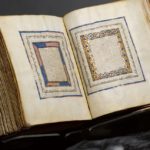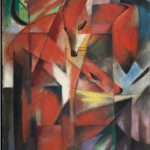
DUSSELDORF.- Working together with the Museum Boijmans Van Beuningen in Rotterdam, over 130 works are presented by Museum Kunstpalast, Düsseldorf, from the multi-faceted oeuvre of Johan Thorn Prikker (The Hague 1868 to 1932 Cologne). The exhibition of this Dutch artist, who mainly became famous through his Art Nouveau works, is the first retrospective of his oeuvre in over 30 years, comprising all the genres in which this versatile artist was active: paintings, drawings, watercolours, mosaics, murals, glass windows, furniture, design objects, textile art, book covers and carpets. On view through 8 July. As well as numerous items from international collections, visitors to Museum Kunstpalast in Düsseldorf will find that the foyer of the collection wing also has a large format window by Thorn Prikker which has been part of the building since 1925. In the same year Thorn Prikker also created two monumental mosaic walls for the corner pavilions of the Ehrenhof.
As well as numerous items from international collections, visitors to Museum Kunstpalast in Düsseldorf will find that the foyer of the collection wing also has a large format window by Thorn Prikker which has been part of the building since 1925. In the same year Thorn Prikker also created two monumental mosaic walls for the corner pavilions of the Ehrenhof.
Johan Thorn Prikker studied painting at the Royal Academy of Art in The Hague, and even his early paintings and drawing are counted among the most outstanding works of Dutch Symbolism. However, Thorn Prikker gained considerably more fame with his works in applied art, ranging from lead glass through furniture, textile art and carpets to monumental mosaics and murals.
In the 1890s the emphasis of his art began to shift towards social critique. “The artist’s successful use of material in his monumental works – with their references to the structures and colours of architecture, both formally and in content – shows that Thorn Prikker continued to develop his ideal synthesis of the arts for the benefit of the people, despite his change of techniques and media.”(Christiane Heiser)
In 1904, after his first successes as an artist, he left the Netherlands to teach at the School of Applied Art and Craft, in Krefeld. Following an invitation by Karl Ernst Osthaus, he then moved to Hagen, where he also designed a monumental window for the town’s central railway station, with the programmatic title: “The Artist as a Teacher for Trade and Commerce”.
 It was not only through his wide-ranging artistic work in the Netherlands and Germany that Thorn Prikker made an immense impact on monumental art in Germany, but especially also through his murals, mosaics and windows and also through his teaching activities at various schools of applied art and craft in Krefeld, Munich, Essen, Düsseldorf and Cologne.
It was not only through his wide-ranging artistic work in the Netherlands and Germany that Thorn Prikker made an immense impact on monumental art in Germany, but especially also through his murals, mosaics and windows and also through his teaching activities at various schools of applied art and craft in Krefeld, Munich, Essen, Düsseldorf and Cologne.
Glass windows and mosaics at the Ehrenhof in Düsseldorf
Thorn Prikker’s most significant legacy in Düsseldorf consists of three works. Firstly, there are two monumental mosaic walls, executed by Otto Wiegmann in 1925, called “Day” and “Night”. Both can be viewed at today’s Ehrenhof, where they occupy the northern corner pavilion of the NRW Forum and the southern corner pavilion of Museum Kunstpalast. Secondly there is also a tall, large-format glass window in the foyer of the collection wing, facing the river Rhine. This window comprises 35 panes and adds a cathedral-like character to the room with its high ceiling. The window was inserted in its current location in 1926 on the occasion of a major exhibition entitled GeSoLei (a German acronym for healthcare, social welfare and physical exercise)
The overall artistic management of the GeSoLei project was handled by Wilhelm Kreis who, in his role as architect and town planner, was responsible for the conceptual and artistic design of the four building sections which were to be preserved after the end of the exhibition. After GeSoLei the building was occupied by the Kunstmuseum (Museum of Art, now Museum Kunstpalast) and by the Reichsmuseum für Gesellschafts- und Wirtschaftskunde (Imperial Museum for Social and Economic Sciences, now NRW Forum). The original Planetarium was transformed into a large function room (now Tonhalle), and only the restaurant (now Rheinterrassen) retained its original purpose.
In 1937 the window in the foyer of today’s museum kunst palast was classified by the Nazis as “degenerate art” and was partly removed. The remaining windows were destroyed in an air raid in 1943. After their replacement with plain white glass in the 1950s, they were restored to their original state during the rebuilding of the Kunstmuseum in 1984, using the cardboard patterns that had been preserved at the Kaiser Wilhelm Museum in Krefeld.
The climax of Prikker’s attention to the forms and motifs of ornamental monumental art came partly with this glass window and partly with his two mosaic walls, “Day” and “Night”, in the corner pavilions of the Ehrenhof. “His anti-naturalist, expressive design and his tendency towards ornamental and abstract-geometric elements combines an architectural approach with the autonomous imagery of two-dimensional art. What makes his mosaics, in particular, so convincing is not just this “cleansed” imagery, but also the way he composed his art with the material – and not for the material.” (Barbara Til)







